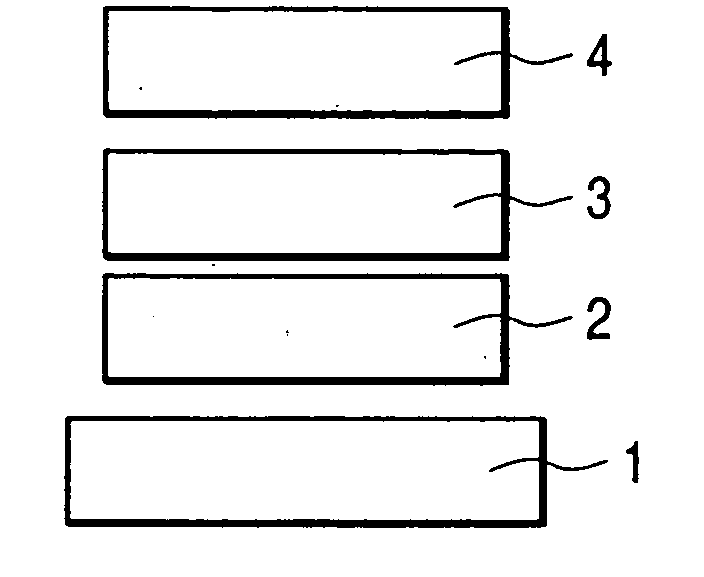Spiro compound and organic luminescence device using the same
a luminescence device and organic compound technology, applied in the field of organic compound and organic luminescence device using the same, can solve the problems of insufficient characteristics of luminescent material or electron-transporting material, many problems to be solved regarding durability, etc., and achieve high luminance, high durability, and high efficiency
- Summary
- Abstract
- Description
- Claims
- Application Information
AI Technical Summary
Benefits of technology
Problems solved by technology
Method used
Image
Examples
synthesis example 1
[0062] [Synthesis of Exemplified Compound No. 1]
[0063] In a 500-ml three-neck flask, 2.0 g (3.16 mmol) of 2,2′-7,7′-tetrabromo-9,9′-spirobifluorene [1]*1), 4.5 g (19.0 mmol) of 9,9-dimethylfluorene-2-boronic acid [2], 140 ml of toluene, and 70 ml of ethanol were added, and an aqueous solution of 25 g of sodium carbonate / 130 ml of water was dropped thereto with stirring in a nitrogen atmosphere at room temperature, followed by the addition of 0.7 g (0.63 mmol) of tetrakis (triphenylphosphine) palladium (0). After stirring the mixture for 30 minutes at room temperature, the temperature is allowed to rise to 77° C., followed by stirring for 8 hours. After the reaction, an organic layer was extracted with chloroform and was then dried with anhydrous sodium sulfate, followed by purification with a silica gel column (hexane+toluene mixture developing solvent). Consequently, 2.5 g (73% yield) of the exemplified compound No. 1 (white crystal) was obtained.
synthesis example 2
[0064] [Synthesis of Exemplified Compound No. 7]
[0065] In a 500-ml three-neck flask, 2.0 g (3.16 mmol) of 2,2′-7,7′-tetrabromo-9,9′-spirobifluorene [1], 4.7 g (19.0 mmol) of pyrene-1-boronic acid [2], 140 ml of toluene, and 70 ml of ethanol were added, and an aqueous solution of 25 g of sodium carbonate / 130 ml of water was dropped with stirring in a nitrogen atmosphere at room temperature, followed by the addition of 0.7 g (0.63 mmol) of tetrakis (triphenylphosphine) palladium (0). After stirring the mixture for 30 minutes at room temperature, the temperature is allowed to rise to 77° C., followed by stirring for 8 hours. After the reaction, an organic layer was extracted with chloroform and was then dried with anhydrous sodium sulfate, followed by purification with a silica gel column (hexane+toluene mixture developing solvent). Consequently, 2.3 g (65% yield) of the exemplified compound No. 7 (white crystal) was obtained.
synthesis example 3
[0066] [Synthesis of Exemplified Compound No. 14]
[0067] In a 300-ml three-neck flask, 2.0 g (3.16 mmol) of 2,2′-7,7′-tetrabromo-9,9′-spirobifluorene [1], 3.2 g (19.0 mmol) of carbazole [2], and 150 ml of xylene were added, and 2.0 g (20.9 mmol) of t-butoxy sodium was added thereto with stirring in a nitrogen atmosphere at room temperature, followed by heating the mixture to a temperature of 50° C. In this mixture, a 5-ml xylene solution of 0.035 g (0.16 mmol) of palladium acetate and 0.032 g (0.16 mmol) of tri-t-butylphosphine was added, followed by heating the mixture to 130° C. and stirring for 8 hours. After the reaction, an organic layer was extracted with chloroform and was then dried with anhydrous sodium sulfate, followed by purification with a silica gel column (hexane+toluene mixture developing solvent). Consequently, 1.7 g (55% yield) of the exemplified compound No. 14 (white crystal) was obtained.
PUM
| Property | Measurement | Unit |
|---|---|---|
| luminescence | aaaaa | aaaaa |
| thickness | aaaaa | aaaaa |
| thickness | aaaaa | aaaaa |
Abstract
Description
Claims
Application Information
 Login to View More
Login to View More - R&D
- Intellectual Property
- Life Sciences
- Materials
- Tech Scout
- Unparalleled Data Quality
- Higher Quality Content
- 60% Fewer Hallucinations
Browse by: Latest US Patents, China's latest patents, Technical Efficacy Thesaurus, Application Domain, Technology Topic, Popular Technical Reports.
© 2025 PatSnap. All rights reserved.Legal|Privacy policy|Modern Slavery Act Transparency Statement|Sitemap|About US| Contact US: help@patsnap.com



